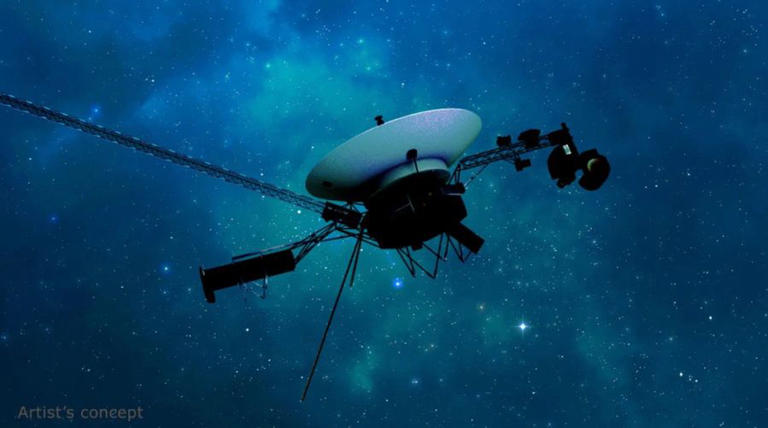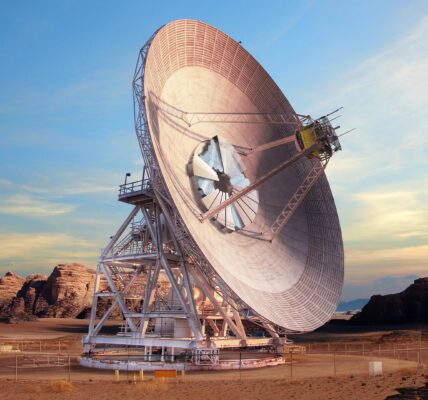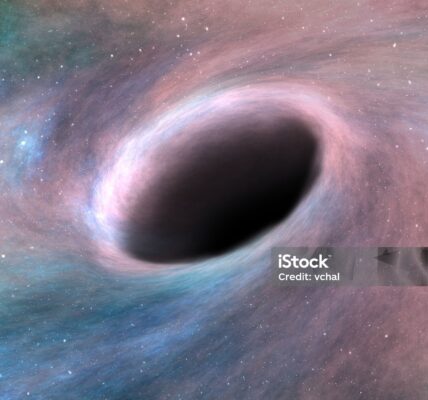Voyager-1 Communication Challenges: NASA Turns to Decades-Old Transmitter for Spacecraft Signal Restoration
“Voyager-1 communication challenges push NASA to re-establish a weak signal with the aging spacecraft, utilizing a backup transmitter not activated since 1981 to reconnect across billions of kilometers.”
Launched in 1977, Voyager-1 has journeyed farther than any other human-made object, venturing into interstellar space and providing us with invaluable data from beyond our solar system. But as it travels through uncharted territory more than 25 billion kilometers from Earth, NASA faces increasing Voyager-1 communication challenges. Recently, a malfunction forced NASA engineers to revert to a transmitter last used in 1981, creating new obstacles in their efforts to stay connected with this pioneering spacecraft.

© JPL-Caltech, NASA
Unexpected Glitch Triggers Communication Challenges
On October 16, NASA sent a command to activate one of Voyager-1’s onboard heaters. This simple action unintentionally triggered the spacecraft’s fault protection system, which is designed to automatically conserve power by shutting down non-essential functions when issues arise. In this case, the system deactivated Voyager-1’s primary X-band radio transmitter, which typically handles communications with Earth. Instead, the spacecraft switched to an alternative, less powerful S-band transmitter, which had not been used in more than four decades.
This unexpected communication challenge caught NASA’s flight team off guard. Communicating with a signal weaker than the one from the X-band transmitter, and traveling over 25 billion kilometers to reach Earth, required extraordinary effort and patience from the team at NASA’s Jet Propulsion Laboratory (JPL).
The Role of Voyager’s Fault Protection System
Like other sophisticated spacecraft, Voyager-1 is equipped with a fault protection system. This system is crucial for a spacecraft operating in the harsh, power-scarce conditions of deep space, as it monitors and protects against malfunctions that could jeopardize the mission. The fault protection system’s primary role is to conserve energy by shutting off non-critical systems if power limitations arise, ensuring that the most vital functions continue to operate.
During the October 16 incident, this system responded to what it perceived as a potential risk by shutting down the main transmitter. As a result, Voyager-1’s X-band radio transmitter was replaced by the backup S-band transmitter, creating an immediate Voyager-1 communication challenge for NASA’s engineers.
Because the S-band signal is both weaker and uses a different frequency, detecting it required additional adjustments from NASA’s Deep Space Network (DSN) team to lock onto the faint signal. Finally, on October 24, they re-established a connection, though the task of identifying the root cause of the fault protection activation continues.
Reconnecting Over Billions of Kilometers: A 46-Hour Round Trip
One of the most fascinating yet challenging aspects of the Voyager-1 communication challenge is the immense distance that the spacecraft’s signal must travel. Currently located over 25 billion kilometers away, Voyager-1 is navigating the vast, unexplored reaches of interstellar space, far beyond the outer planets of our solar system. As a result, every communication between Earth and Voyager-1 involves a signal that takes approximately 23 hours to reach the spacecraft and another 23 hours to return—a total of 46 hours for each round-trip message.
This delay means that any command sent to the spacecraft takes almost two days for NASA to receive a response, making real-time troubleshooting nearly impossible. When JPL engineers detected the faint S-band signal on October 22, they confirmed that the backup transmitter was functional, which provided some relief. However, this older, weaker transmitter brought its own set of limitations, making the communication challenge even more intricate.
Diagnosing the Issue with the Fault Protection System
With the signal re-established, NASA’s engineers now focus on diagnosing the issue that caused the fault protection system to trigger the transmitter switch. They believe it may take several days or even weeks to identify the root cause due to the communication delay and the complexity of the spacecraft’s onboard systems. Understanding what prompted this system response is crucial for preventing future communication disruptions and preserving the longevity of Voyager-1’s mission.
The investigation process involves analyzing the spacecraft’s responses to various commands and cross-referencing these with data from similar past incidents. Engineers will carefully monitor the behavior of the fault protection system to assess whether additional adjustments are needed to prevent similar Voyager-1 communication challenges in the future.
Voyager-1’s Power and Orientation Systems: Essential for Communication
Keeping Voyager-1 properly oriented towards Earth is essential for maintaining communication, and even this poses significant challenges due to the spacecraft’s age. Voyager-1 relies on liquid hydrazine fuel for orientation adjustments. This fuel is converted to gas and released in short bursts, or pulses, that help the spacecraft maintain its alignment with Earth. Remarkably, Voyager-1 performs around 40 of these pulses each day to stay aligned, which is vital for effective data transmission.
However, the spacecraft’s fuel supply is finite, and each pulse consumes a small amount of hydrazine. This presents another Voyager-1 communication challenge, as NASA engineers carefully balance fuel use to maximize the longevity of the mission. Despite these limitations, Voyager-1 continues to function, a testament to its robust engineering and the ingenuity of NASA’s flight teams.
Voyager-1 in Interstellar Space: Beyond the Heliopause
Voyager-1 officially crossed the heliopause—the boundary marking the end of the Sun’s influence—back in August 2012, making it the first human-made object to enter interstellar space. This boundary separates our solar system from the vast, uncharted territory between stars in the Milky Way galaxy. Since crossing into interstellar space, Voyager-1 has provided humanity with invaluable insights about the environment beyond our solar system, detecting phenomena like cosmic rays and magnetic fields that shape our understanding of this remote region.
This historical journey into interstellar space makes the spacecraft’s continued operation even more remarkable. Even with ongoing communication challenges, NASA is committed to preserving Voyager-1’s ability to send data, as each transmission reveals details about a part of space no other probe has reached.
NASA’s Commitment to Voyager-1’s Legacy
NASA’s dedication to overcoming Voyager-1 communication challenges reflects the profound significance of this mission. Voyager-1 has been journeying through space for nearly five decades, outlasting its initial expectations and continuing to push the boundaries of human exploration. As long as it remains operational, Voyager-1 will keep sending back data from interstellar space, adding to its legacy as a groundbreaking mission in the history of space exploration.
Engineers face increasingly complex challenges to keep the spacecraft functional as it contends with aging technology and a declining power supply. But the scientific value of Voyager-1’s data, along with its symbolic importance as a pioneering human artifact in the cosmos, drives the JPL team to maintain communication despite the odds. With each faint signal and data packet sent across the vastness of space, Voyager-1 continues to inspire a sense of wonder and curiosity about our place in the universe.
Looking Ahead: The Future of Voyager-1
While Voyager-1 communication challenges are likely to increase, NASA’s commitment to this mission shows no sign of waning. Engineers will keep working on solutions to sustain communication, even if it means relying on backup systems and performing diagnostic adjustments. Although the journey of Voyager-1 will eventually come to an end, every day it continues to operate is another day humanity receives insight from interstellar space.
For now, each message received from Voyager-1 brings us closer to understanding the distant environment it traverses, making it a powerful symbol of exploration and endurance. As NASA continues to tackle the obstacles of deep-space communication, the legacy of Voyager-1 serves as a reminder of how far humanity’s curiosity can take us, even billions of kilometers from home.
Related:
Mars Science Helicopter Mission: 5 Exciting Innovations!



